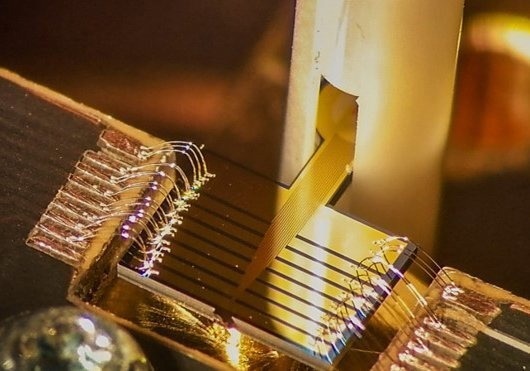A recent study published in the journal Nature Photonics has developed a specialized multipixel superconducting nanowire single-photon detector. This detector ensures both precise timing discrimination and high-count rates, thereby enabling unparalleled performance in quantum key distribution.

Using these sensors, scientists were able to generate a secret key at a rate of 64 megabits per second over 10 km of fibre optic cable. Credit: M. Perrenoud - G. Resta / UNIGE
The concepts of quantum physics allow for the encoding of information, or qubits, in individual light particles known as photons. By transmitting these photons through an optical fiber, this method offers a highly secure means of communication. Despite its potential, the application of this technology has been hindered due to limitations in the performance of single-photon detectors.
Quantum Key Distribution (QKD): Overview and Importance
The development of secure communication technologies is of critical importance in today's world, where sensitive information is regularly transmitted over vast distances.
Quantum key distribution (QKD) is an innovative approach to information security that takes advantage of the principles of quantum mechanics to enable the secure exchange of cryptographic keys over long distances.
Unlike traditional public key systems, which rely on computationally intensive tasks, the security of QKD is based on the laws of quantum mechanics, making it resistant to potential attacks from powerful quantum computers.
As the field of quantum computing continues to evolve, the security of traditional public key systems is under threat. If a large-scale quantum computer were to become widely available, it would render these systems vulnerable to attacks they cannot withstand with current technologies.
However, QKD offers a potential solution to this problem. Using QKD in combination with the one-time pad, private communication can be secured even in the face of future advancements in quantum computing technology.
QKD Systems for Secure Communication
In recent years, quantum key distribution (QKD) has emerged as a promising solution for secure communication. Many more protocols have been created since the release of the BB84 protocol with the purpose of expanding the range over which a secret key may be produced or optimizing the secret key rate (SKR) over a specific distance.
While these protocols differ in complexity and level of device independence, they all aim to improve the performance of QKD systems.
However, despite these advancements, the speed of single-photon detectors used to receive information remains a major limitation for the widespread application of QKD. These detectors must recover for approximately 30 nanoseconds after each detection, which severely limits the throughput of secret keys to about 10 megabits per second.
This bottleneck in performance poses a significant challenge to the practical implementation of QKD systems, highlighting the need for further research and development in this field.
Highlights of the Current Study
In this study, the researchers aimed to improve the secret key rates (SKRs) of quantum key distribution (QKD) systems by developing a custom superconducting nanowire single-photon detector (SNSPD) with high efficiency and count rates.
The SNSPD was optimized for performance and designed to achieve high SKRs. To test their system, the researchers implemented a simplified BB84 protocol with time-bin encoding and one decoy state, with a clock speed of 2.5 GHz.
The researchers used this protocol to demonstrate the effectiveness of their custom SNSPD in generating an SKR of 3 Mbps over a distance of 100 km and more than 60 Mbps over 10 km.
"Our detectors can count twenty times faster than a single-wire device," explains Hugo Zbinden, a co-author of the study. "If two photons arrive within a short time in these new detectors, they can touch different wires and both be detected. With a single wire this is impossible."
Future Perspective
The integration of fourteen nanowires into the detector has resulted in a significant increase in detection rates. In addition, the use of shorter nanowires has also decreased their recovery time.
These sensors have enabled the researchers to generate a secret key at a rate of 64 megabits per second over a distance of 10 kilometers. This rate is five times better than the current technology available for the same distance. Moreover, the new detectors are not more complicated to manufacture than the current devices on the market.
These findings are promising for developing ultra-secure data transfer, which is critical for institutions such as banks, healthcare systems, governments, and the military. They can potentially revolutionize various fields where light detection is crucial, such as astronomy and medical imaging.
In the future, researchers aim to further improve the efficiency and speed of quantum key distribution systems to meet the increasing demand for secure data transfer in various industries. This research also highlights the importance of continued investment in cutting-edge technologies to ensure the security of sensitive information.
Reference
Grünenfelder, F. et al. (2023). Fast single-photon detectors and real-time key distillation enable high secret-key-rate quantum key distribution systems. Nature Photonics. Available at: https://doi.org/10.1038/s41566-023-01168-2
Disclaimer: The views expressed here are those of the author expressed in their private capacity and do not necessarily represent the views of AZoM.com Limited T/A AZoNetwork the owner and operator of this website. This disclaimer forms part of the Terms and conditions of use of this website.